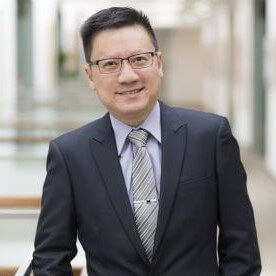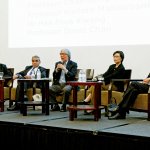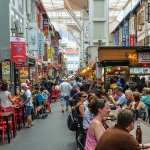By the SMU Social Media Team

Prof Lily Kong, SMU President
Sixty years ago, the Housing & Development Board (HDB) was established to solve the urgent challenge of providing sanitary and affordable housing for the growing population of Singapore, a significant portion of which still lived in squatter settlements.
Today, the challenges facing the country are of a different nature. Moderating the “Designing for Life: What is the Future of HDB Living” webinar in October, Singapore Management University President and Lee Kong Chian Chair Professor of Social Sciences Lily Kong summed up the multifaceted considerations for HDB: “With new trends such as an ageing population, climate change, technological disruption, a more diverse society, and changing aspirations, as well as the need for greater public engagement, what will the future of public housing look like?”
The webinar opened with Deputy Prime Minister Heng Swee Keat launching HDB’s new “Designing for Life” Roadmap, which will guide its work in this area over the next 10 to 15 years.
Designing for life: the future of HDB
Speaking at the webinar were HDB CEO Dr Cheong Koon Hean; John Wong, Isabel Chan Professor in Medical Sciences, Senior Vice President (Health Innovation and Translation) at the National University of Singapore and Senior Advisor to National University Health System; David Chan, Professor of Psychology at SMU and Director of the university’s Behavioural Sciences Institute; and Volker Buscher, Chief Data Officer of Arup, a multinational professional services firm.
Drawing from their fields of expertise, the speakers touched on different facets of the “Designing for Life” Roadmap, which aims to enhance residents’ holistic well-being in the planning and designing of HDB towns.
Live well, live smart, live connected
The blueprint’s three pillars reflect this approach. The first pillar, “Live Well”, focuses on enhancing the physical, mental and social well-being of residents across generations. The second pillar, “Live Smart”, refers to the harnessing of technology to enable convenience for residents and more sustainable lifestyles and township management systems. The third pillar, “Live Connected”, explores more opportunities for residents to connect with one another and contribute to the shaping of community spaces.
Prof Wong elaborated on the idea of designing environments that can help lengthen one’s “healthspan”—the length of time that one is living in good health (as compared to lifespan, which is the length of time that one is alive). Mr Buscher shared his thoughts on the new purposes of technology beyond efficiency including how technology can enable sustainability, economic success (as defined by metrics such as job creation) and people’s well-being.
Well-Being: a sense of connection
Speaking on the overarching concept of well-being and connectedness that is at the centre of the HDB Roadmap, Prof Chan noted that people’s well-being has to be seen in terms of the lived experiences that affect one’s health and quality of life, and it also includes a sense of connection to physical environments and as well as other people. He added that well-being was not just a positive end in itself, but also a means to other positive ends such as pro-social behaviours.
“This connectedness can be to the physical space around us, but also to the social space—and the people you interact with outside your home,” explained Prof Chan.
“There’s also a psychological component of connectedness, which is about how these physical and social interactions affect our psychological well-being and the way we think, feel, and act. When faced with new demands from Covid-19 that we need to adapt to, for example, positive well-being contributes to the psychological capital that we need, which includes the sense of self-efficacy, optimism, hope, and resilience.”
The 5Cs
To enhance such connectedness, Prof Chan proposed focusing on what he calls the 5Cs: Convenience (such as easy access to amenities and facilities); Connectivity (including effective park connectors, public transport, walkable neighbourhoods, digital connection); Community (providing opportunities for naturalistic interactions which may include white spaces where residents can co-create initiatives together and develop strong bonds); Collaboration (different government agencies and other stakeholders working well together); and Contribution (creating opportunities for residents to help others and give to their community).

Prof David Chan, Director, SMU Behavioural Sciences Institute
But these 5Cs are dynamic conditions and not static criteria. “For example, what we consider convenient now can change quite abruptly in the future. Most of us will think of medical care, playgrounds, and access to groceries as the most important amenities when designing for convenience,” said Prof Chan. “But as we digitalise, perhaps access to shops with digital services or telco branches will become important even at the smaller precinct level and not just at the larger neighbourhood level.”
So, when looking at these five factors, it is important to take an agile approach and learn to see things from the residents’ perspectives, he added.
“An agile and adaptive approach also means it’s important to anticipate changes, so that we are not always playing catch up,” said Prof Chan, adding that genuine co-creation requires not only the ability to look at things from others’ perspectives, but also the humility to question one’s own assumptions and acknowledge that no single individual or entity has all the answers—all while accompanied by a learning orientation and positive attitude towards collaboration.
The unifying goal for all these elements is to foster a sense of belonging and identity for the residents of a community, he said. This will become more important when crises, such as the current pandemic, heighten a sense of isolation and self-centred needs. In times of partial lockdowns for instance, how can townships be designed to ensure residents are looking out for one another because they have developed a sense of community? Ultimately, HDB is about “Health, Design, Bonds”, Prof Chan concluded in his response to a question about what really matters.
Indeed, because of Covid-19, HDB is already mulling ways to stay ahead of the curve should the need to work and study from home persist, said Dr Cheong, who nevertheless noted that it was necessary to design for flexibility to cater for change.
As the session drew to a close, Prof Kong also underlined the importance of public engagement to the future of public housing, and reiterated Dr Cheong’s point about how HDB had laid crucial foundations for these present aspirations generations earlier.
Said Prof Kong, “We are able to do this with confidence moving ahead because of the past efforts of having already built neighbourhoods, having already thought through issues like how to set up precincts, what is (the) human scale that is encouraging of social and human interaction, and also (made) past efforts in building cyber connectivity.”
Wrapping up her comments, Dr Cheong encouraged members of the public to visit the virtual Designing for Life Exhibition to find out more about the initiatives under the new Roadmap, and share their feedback and suggestions with HDB.
“An agile and adaptive approach also means it’s important to anticipate changes, so that we are not always playing catch up.”










